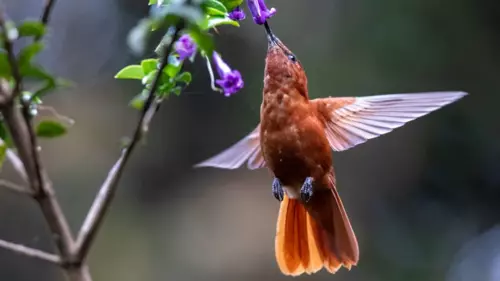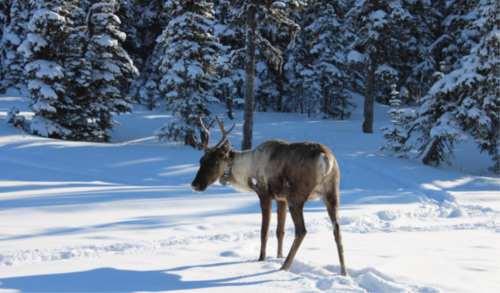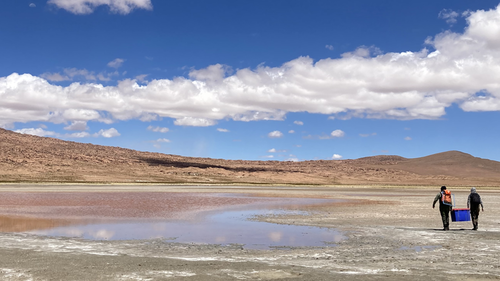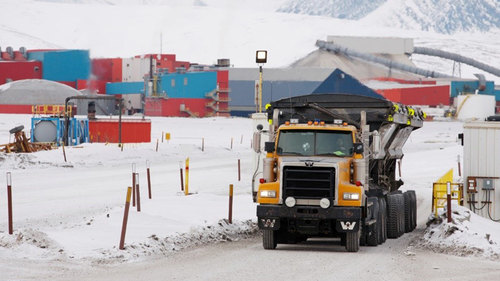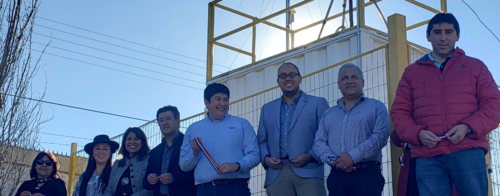Episode 6 Episode 6: Better Than We Found It
May 3, 2023
Guests
- Carleigh Whitman, Director, Environment, Teck
- Daniel Desjarlais, Sales and Marketing Manager, Twin Sisters Native Plants Nursery
- Jillian Lennartz, Manager Sustainability Reporting, Teck (“Jill from Teck”)
6
In this episode
We all know mining disturbs land, so proper land reclamation is a critical part of the process. Modern mines aren’t just cleaning up after themselves. Their goal is to leave an area better, stronger, and more diverse than they found it. In this episode, we highlight Teck’s Nature Positive initiative, and we speak with a nursery that restores native plants across northern B.C.
Guests:
Carleigh Whitman, Director, Environment, Teck
Daniel Desjarlais, Sales and Marketing Manager, Twin Sisters Native Plants Nursery
Jillian Lennartz, Manager Sustainability Reporting, Teck (Jill from Teck)
Transcript
00:00:03
Robin Stickley: I am walking the beautiful trails right now at Pacific Spirit Park. I just kind of felt like, ahead of today's episode, this would be the perfect place to come and reset. It's not always easy to be totally present in the world today and stay in the moment, but this is a place where it's almost impossible not to be totally in the moment. It's so peaceful. Nobody out here is on their phones. It's just nature all around. I think this forest has seen many, many versions of me over the years. I think it's heard a lot about me. I just feel gratitude for it. And when I look around, I just hope that my great grandkids will walk here. That's it Lukey. Oh, butterfly.
I want to think about the phrase, better than we found it, for a moment. I'm sure you've heard the phrase before. And the context of it is what really drives our relationship to it. Within the context of mining, moreover, sustainable mining, it's important that we begin to understand how the industry is moving towards a green future, while working to leave its sites both former and active, better than they found them. What exactly goes into this process? Who's behind these processes? And how will it change the world over the next century? Is it as simple as just going out and spreading grass seed, planting a few conifers, calling it a day? Well, my work in this show has taught me that when it comes to mining, nothing is quite as simple or easy as that. For the real answers from a couple of experts in this part of the industry, we're going to hear from guests, Carleigh Whitman, director of environment at Teck, and Daniel Desjarlais, sales and marketing manager at Twin Sisters Native Plant Nursery in today's episode.
I'm Robin Stickley. This is Why We Mine. I'm back with Jill, Teck's manager of sustainability reporting and our friendly neighbourhood-
00:02:41
Jill: Scientist with social skills.
00:02:44
Robin Stickley: Hi, Jill. What are we learning about today?
00:02:48
Jill: We are learning about carrying capacity and what it has to do with mining. So caring capacity is a concept that has to do with ecology, how much of a species an environment can support.
00:03:01
Robin Stickley: So how much of something the environment can carry.
00:03:05
Jill: That is exactly the way to think of it. Okay. Picture in your mind a forested island and on that island there are some key things, a few deer, a few wolves.
00:03:16
Robin Stickley: Okay, this is already sounding like cutthroat island. I'm worried about the deer.
00:03:21
Jill: I think that is a safe worry in most situations. So it's set up this way for a good reason. It makes for a really simple example. All right, so let's focus on the wolves. They're at an island with a really good food source. Our poor friends, the deer, the wolves munch on a deer. They're happy, they start a family. And all of the rest of the surviving deer do the same thing, and all is well. It's a nice balanced carrying capacity. The amount of wolves there keep the deer population in check, and the amount of deer keep the wolf population sustained.
00:03:55
Robin Stickley: I am just on the brink of breaking into circle of life here, by the way.
00:03:59
Jill: Can encourage you? So let's say something in that balance changes. For example, maybe one year, just for whatever reason, there is a bunch more wolf cubs than usual, and suddenly the wolves need to hunt more deer to sustain their numbers. So you have a lot more wolves. As a result, the deer population dips below the amount needed to sustain that new larger wolf population. And then that kicks off a whole sequence of events like the wolves don't get enough food, their population numbers decline until they reach a new balance with deer, and the deer population can then eventually recover. Let's say the wolf population declines, and then you have more deer because they're not getting eaten as much, and then they eat more plants. And so the plant population declines, and then everything that relies on those plants-
00:04:51
Robin Stickley: And I'm with you. I'm actually super, super following along. You're doing a great job, but I'm not sure how it relates to mining.
00:04:57
Jill: That makes sense. So understandably, mining is one of those activities that disturbs an area for just the set period of time, the life of the mine, and we want to make sure that all of that great natural diversity at that site, plant species, animal populations, are able to thrive once mining operations are over.
00:05:17
Robin Stickley: Okay, I got you. So here's where the conservation piece comes in.
00:05:20
Jill: Right. Right. So mining companies will establish a really large area of conservation near the site that they're working on where all of those natural species can thrive while being protected. And then after the mine closes, the mine site gets replanted with all native species, and all of those conserved wildlife that are off to the side and that conservation area can then move back into the area.
00:05:42
Robin Stickley: Very, very cool. Such a smart way to approach it. I am excited now to hear more about how that caring capacity gets boosted and the environment can rebound hopefully to what it was before
00:05:55
Jill: And I can't wait to hear too. Please have fun.
00:05:58
Robin Stickley: Thank you, Jill. I'm going to go check in with the experts now to dig into this some more. You're listening to Why We Mine. I'm Robin Stickley. I'd like to begin today's conversation by talking to Carleigh Whitman, director of environment at Teck about biodiversity and reclamation, and how the mining industry plays a role in both. Carleigh Whitman, welcome to Why We Mine. So delighted to have you here. I'm really excited about our chat today.
00:06:28
Carleigh Whitman: Yeah, pleasure to be here, Robin.
00:06:29
Robin Stickley: So Carleigh, I'd love to know more about you and how you came to the world of mining. Let's talk about that.
00:06:35
Carleigh Whitman: Sure. Well, I started in conservation biology actually is what I studied in school, and I also studied commerce because I really felt that to make a difference... So much happens in the world of business and marrying that was really important to me. So that was the path that I took, and I ended up going to law school as well. So I've been an environmental lawyer for a few decades now, hard to believe. And so I practiced at a law firm for a while and had different clients from a range of different industries, and really drawn to mining because of both it is an industry that has a significant impact on the land, but it is also an industry that people are very passionate about that land, just given that a lot of people attracted to the industry are people who love the outdoors.
Whether they're geologists or outdoor enthusiasts, that tends to be a lot of the people that are drawn to mining, so people that have an impact but also want to make a big difference. So that's why I knew it was the place for me.
00:07:27
Robin Stickley: So love of the planet has been the foundation for you?
00:07:30
Carleigh Whitman: Yes. I grew up in British Columbia, fortunate enough to be in an area with lots of wilderness nearby and spending a lot of time with my parents and grandparents outdoors as a child, and so that's really shaped who I am as a person.
00:07:43
Robin Stickley: I think it's interesting that you're saying mining has always been an area of interest to you, and partly because of how much you love environmental issues being outside, that kind of thing. Because I think for some people, those two ideas maybe don't always go together. Fair to say?
00:07:57
Carleigh Whitman: Yes, definitely. And there's lots of perceptions out there, but the act of mining is to be outdoors. You're not operating a shovel and sitting back in away from the environment. And so I think-
00:08:09
Robin Stickley: Right.
00:08:09
Carleigh Whitman: ... usually where mining occurs tends to be in more remote or rural areas, so people who are attracted to that lifestyle also are really interested in living that kind of a lifestyle where they can be in the natural environment a lot and not be in a city.
00:08:21
Robin Stickley: Let's talk about reclamation, Carleigh. I'm curious to know how reclamation fits into the mining world.
00:08:29
Carleigh Whitman: Yeah. Well, it's interesting. I have young children. I gave a talk to my son's preschool not too long ago and we talked about mining and just to see what understanding three- year- olds had, and they were very astute, actually. We said, " If you're digging a big hole in the ground and mining the metals out of it, what do you do? What do do with a hole in the ground when you're done?" And they said, " Oh, you fill it back up." And it just kind of hit home for me, just that, yes, that understanding of, how do we reclaim things? And so that could be through planting trees or grasses, that could be through filling up old pits, but how do we get that landscape back?
Some people talk about mining as a temporary land use. So they talk about the end land use being, where is it going to return at the end of the day? We're not going to be mining here forever, the deposits are finite, so how do you put it back? And in every jurisdiction that we operate, it's also a regulatory requirement. So it's something that governments mandate for mining companies, and you have to have a plan for that before you can even put a shovel in the ground.
00:09:26
Robin Stickley: Can we kind of flesh this out just a little bit more, Carleigh, in terms of what you're seeing with respect to mining around biodiversity and reclamation? Can we talk a little bit more about that?
00:09:35
Carleigh Whitman: Yeah, certainly. So how reclamation has evolved over the last few decades has gone from simply planting trees... And I think that's how reclamation was often perceived, that you plant the trees and then you walk away. We do a lot of work now to identify what ecosystems are there before we mine, and then we try to progressively reclaim as well. We don't wait until mining is all finished. If there's an area that we can start reclaiming early on, then we do that. And that holds true for exploration as well, sites that don't even end up becoming a mine.
So that progressive nature of reclaiming continuous throughout the mining life cycle, and it also extends to looking at those native ecosystems. So we know that it's not just a case of putting in trees and everything else just somehow shows up.
We need to create that. And so a lot of that work and the exciting part of it I think is working with local communities, indigenous groups on native plant nurseries because a lot of these species aren't commercially available.
So that's something that we devote a lot of our effort and energy to, is just how do you, in essence, cultivate some of these wild species that you can plant them?
00:10:42
Robin Stickley: I have to imagine things have changed a lot even in say 40, 50 years. It must look very different what you're doing today than what you were doing.
00:10:50
Carleigh Whitman: Yes. And I would say even the last 10 years, things have changed rapidly. It's a definitely an accelerating pace in this field and I think a lot of that is due to... When I say we don't just plant things and walk away, we monitor. And so that's the other part. When you think that you've done it in a way that will work, sometimes we're wrong, and we have to go back and say, " Okay, well, how do we go back into this landscape then and create different things?" So one of the really exciting things we've been doing lately is around even starting from the mine planning stage. So how we design our mine at the outset has the end in mind. 20 years ago, 10 years ago, you would've seen a mine plan that just had steep sides, and now we're looking at things like wind scouring and escape terrain for ungulates, and how do you build that into the mine at the outset? So there's less for you to do at the back end. You just do it right from the start. And then creating even microclimates.
So we know for a lot of these little trees, they're planted on bare rock. And I say to people, If you ever try to grow a garden at home, you have soil, and it can still be really tricky." And we do that with no soil. So how do you create soil? How do you create the conditions that will have these little pockets in different areas for different plants to survive? And once life gets a foothold again, then it can accelerate from there. But having just a straight slope and planting things on it, we found, maybe it's intuitive in hindsight, but it just doesn't do as well as when you have natural topography.
00:12:15
Robin Stickley: I'm going to ask you if you can kind of paint a picture, if you can, for me of what the land might look like in almost a before and after, because I've got an idea of this very barren landscape, humble weed rolling through, and then after, it's green and lush and forested, but I'm not sure that maybe is a truly simple way of looking at it. Can you paint a picture for me?
00:12:35
Carleigh Whitman: It depends. We operate in vastly different ecosystems on this planet, from the high arctic to the Atacama Desert in Chile to old growth forests. And so each ecosystem needs to be really appreciated and understood for what it is, rather than having an end goal in mind that all reclamation or all end points are going to look the same. We really do a lot of work on, what is the baseline? What does this ecosystem look like before? And also having, call them benchmarks, as climate change makes impacts and we mine over decades in many cases, returning it to what it looked like before we mine. The surrounding environment may have changed too, so we need to keep our eye on that as well. But certainly if you look at a mine, other than an underground mine, you're not going to see a lot. But any open pit mine looks exactly what it sounds like. It looks like a big pit, a big surface in the earth.
There is no greenery. There can be a lot of dust if you're not mitigating it, just because you are exposing rock. What it looks like during mining and what it looks like after reclamation are very different, just with that presence of greenery. And I think that does lead to, how do you also get that visual quality back quickly, knowing that some of the ecosystems that you're targeting take hundreds of years to replace what was there before? So that's something also that we've been learning more. How do you create successional ecosystems rather than trying to just get right to the end result as quickly as you can, because sometimes that's just not the way that works in nature?
00:14:05
Robin Stickley: So that was something I'm thinking about. What factors are at play to have a truly successful reclamation? And I know that that's an ongoing process. Maybe there isn't an end point, maybe it goes on forever, but what success in reclamation where mining is concerned?
00:14:19
Carleigh Whitman: Success is really, for us, getting as close as possible to the preexisting ecosystems, and that those ecosystems are diverse and that they're, so that you wouldn't be able to tell the difference between that and... Say there was a national park 20 kilometres away, you shouldn't be able to tell the difference. It is actually impossible for that to happen with mining because there are features that we cannot fully reclaim, such as former tailing storage facilities, high wall. So if you have a pit, there's a very steep wall. You can do things to smooth that out, but there will always be a wall there. It will never look fully natural. So keeping in mind that we can't put things back exactly the way they were. We do the very best that we can.
00:15:02
Robin Stickley: So in recognizing and in acknowledging some of that impact that is made to land, what's your response to people who might feel skeptical about this nature positive talk, and they might throw out words like greenwashing, Carleigh? How do you square with that, or how do you address that argument?
00:15:20
Carleigh Whitman: For us, when we talk about nature positive, it's looking at things from a landscape scale. So the first step is acknowledging that we have an impact. The work that we do has an impact, and sometimes irreversible on the landscape. So being honest and transparent about that, but then saying from a landscape perspective, where are there areas that we can make the most difference?
00:15:42
Robin Stickley: Talk to me a bit about the nature positive initiative.
00:15:45
Carleigh Whitman: Sure. So the term nature positive has come up in the last couple of years as a way on the international stage... There was no one global goal for nature. So people knew that nature loss is occurring, but well, what's the goal? What are we trying to get to? And so that's where this term nature positive came out, and basically it's to halt and reverse biodiversity loss by 2030 with full recovery by 2050.
So at Teck, we thought about, well, what does that mean for us? How it applies to companies, that is still being debated and discussed. And there is actually a meeting in December of this year. It's the convention on Biological Diversity COP15, it's called. So this meeting that's being held in Montreal in December is expected to set the new targets for the next decade on biodiversity. And so for us, nature positive was a way for us to engage in that dialogue, and it means, the way that we've defined it at least, is that by 2030, our conservation protection and restoration will exceed the disturbance that our activities have caused from a 2020 baseline.
00:16:48
Robin Stickley: So halt and reverse nature loss, right? That sounds like a big, big goal.
00:16:53
Carleigh Whitman: It is a big goal, and it's going to be very challenging for us to get there. And it is very intertwined with climate change, and we're not going to solve the climate crisis unless we solve the biodiversity crisis and vice versa. So yes, there's a lot of work to be done, but I think the good news is that there's something that all of us can do.
It's a goal that we can all work towards, either as a company, but also in our personal lives just around whether it's putting out a window box with flowers to encourage pollinators or... Little steps do make a difference because it is so local. And climate change is, at its global scale, very daunting. And I think for biodiversity loss, what really matters is the biodiversity where you live, and what can you do to make a difference. And whether you're a mining company, or as I said, an individual, I think there's something that we can all do, so we should take heart from that.
00:17:42
Robin Stickley: Looking ahead now to the next 10 or 20 years in reclamation, what does that look like?
00:17:48
Carleigh Whitman: The future is going to look like a lot more disclosure. You're going to see from mining companies about the impacts that they have on nature. There is also going to be more, and certainly from us, but more expectation around ensuring that you are offsetting your impact before it occurs. So while reclamation is very important and we need to do it, when we are at the tipping point that we are right now with biodiversity on this planet, that it is being lost at an increasing rate, to really halt and reverse that, it means that we need to assess our potential impact before it occurs, and then to take steps, before we put a shovel in the ground, to raise the level of the environmental wellbeing, I would say, of those ecosystems before we have our impact. So instead of drawing down from the bank and then replacing it later, it's putting more into the bank at the outset, and we're going to replace it later as well to remediate our impact.
00:18:41
Robin Stickley: That's an encouraging note to end on. I have so enjoyed listening to you and learning from you, Carleigh. Thank you so much. Next up, Daniel Desjarlais, sales and marketing manager of Twin Sisters Native Plant Nursery. He's here to talk about the process of growing plants, trees, and shrubs for reclamation. Stay tuned for the next part. And just a reminder, Why We Mine is a podcast brought to you by Teck, that explores how the world we know relies on the products of mining we need to thrive. I'm your host, Robin Stickley. I hope you're liking the show so far. If so, please follow, subscribe, and share Why We Mine with your friends.
Daniel, welcome to this episode of Why We Mine. We're so excited to have you here. And I'm so keen to talk to you today, Daniel, but can I ask a little bit about your inspiration in terms of working there and how that came about?
00:19:45
Daniel Desjarlais: I started working at the nursery because of COVID. I was actually a professional chef by trade. And then because of COVID, it was really hard to find a job. I ended up coming out to the nursery because they were hiring packers to pack up orders and stuff. I ended up just liking the job a lot because I've always loved nature, and then also, I was really curious in how using traditional native plants in food was going to be, how I could turn that into a restaurant.
00:20:13
Robin Stickley: You could marry both of those worlds pretty beautifully though, right, culinary world and what you're doing right now
00:20:18
Daniel Desjarlais: Yeah, a hundred percent.
00:20:20
Robin Stickley: I want to hear all about the work that's being done and what you're doing at Twin Sisters.
00:20:25
Daniel Desjarlais: I'm the sales and marketing manager at Twin Sisters Native Plant Nursery. So I take care of all the contract orders, and then same with all our retail stuff, because we do also sell annual flowers and stuff like that to our more local community. What we mainly do with our company is grow native plants for reclamation projects all throughout northern northern BC, and we are slowly starting to get into other parts of BC and a little bit into Alberta as well. We have two greenhouses that are 200 feet each, and we can fit a total of 500, 000 plugs in them. It's a big operation, but it's really small for a native plant nursery, to be honest. We have a capacity of 500, 000 plugs, but we sell those every year. We're always at full capacity for our contracts, so all of our native plants are sold every year. That's really good for us.
00:21:19
Robin Stickley: Can you just walk me through the process. When you're talking about working with this native plant reclamation and working with companies, you're talking about going from seeds to plugs, and I need to understand a little bit more about how long it takes to do that and how that works.
00:21:35
Daniel Desjarlais: We encourage companies to go out to these sites and collect as many of the different native species plants and conifer trees and deciduous trees and all of it and send it to us, and we will hold those seeds. We will grow those seeds that came from that land and we'll sell them back to you for you to replace basically everything so that we're trying to replace the biodiversity that was removed from that land and replacing it back with what was already there. You can take seed from one zone and planted it in another zone, but the only problem is throughout the years, all these plants genetically are changed to adapt to the zone that they've lived in. So it's a lot harder for a plant from down south to come up to our climate than it would be for one from our climate to go down there.
00:22:27
Robin Stickley: Daniel, because you're saying you have to go into the area before any damage is done to make sure you're not guessing at what was there, and you're going to replace what was originally there. How long do you hold onto those seeds? And what's the timeline on growing them into plugs before they go back into that area?
00:22:44
Daniel Desjarlais: Typically, we try to use seeds within five years. Obviously, the viability of seeds depends on each seed. There's some that will last for years and years. There's others that will only last a year. When I say viability, I mean the germination rate, the amount that will actually grow and won't just sit there as a seed.
00:23:06
Robin Stickley: I can see why you need more greenhouse space though, right? Because if you have to hold onto that for an extended period of time, you run out of room.
00:23:13
Daniel Desjarlais: Those seeds that get sent to us we'll actually put in a freezer as our seed vault, and we'll have them labeled from the seed zone that they came from, what site, and what elevation coordinates and everything, all that information, right? So we know what zone they came from, pretty much exactly where they came from.
00:23:35
Robin Stickley: When it's time to bring biodiversity back to a former mining site, are there any other considerations, Daniel, that you have to take into account?
00:23:43
Daniel Desjarlais: Planting native plants, it does a lot for nature in itself. It helps repair itself. There's a lot of native plants out there that are nitrogen fixers, for example, right? These plants, they'll grow and they'll provide nitrogen, which is food or what makes plants green and grow basically. And they actually will take the air and the carbon dioxide around them and they'll put it back into the earth, and it provides carbon. And that actually feeds all the other native plants that's growing around it. It feeds them. And then that, in turn, helps them grow and become bigger and everything like that. So going through and just planting conifers or throwing down grass seed is actually really bad. Because if you are doing it in remote areas where you're wanting the biodiversity to come back, throwing down grass seed prevents everything else from growing.
00:24:41
Robin Stickley: You can still figure it out after the fact, just takes a little bit more investigative work. What about the benefits in terms of... I'm thinking about things like ground structure, when we think about natural disasters like flooding and that benefit there, Daniel. Can you talk about that a bit?
00:24:56
Daniel Desjarlais: Roots from vegetables and grass, they only grow to about two feet, two, three feet into the ground, which provides some structure for mother nature. It doesn't provide a lot. And also, it doesn't absorb water nearly as much because those plants don't need as much water. When you look at the native plants, their roots can grow anywhere between 15 to 20 feet long and deep into mother nature. Because of that, it actually provides a ton more stability and structure in the soil, and plus, it provides air sockets for water to flow through it and for these plants to suck up that water. So with that being said, because of this planting native plants, in certain areas, in big commercial areas like cities, it can be really beneficial because the roots can provide structure, helping prevent landslides.
00:26:00
Robin Stickley: When you're in this work, are you informed by the knowledge of your elders in the community?
00:26:00
Daniel Desjarlais: We do work pretty closely with our elders. Mainly, a lot of it is trying to get traditional names or even just uses for all these native plants. There's a bunch of elders that actually come and work here and help us with packing and stuff. They just love being with the native plants.
00:26:16
Robin Stickley: What do you see in terms of trends going forward into the future, just as we wrap up here, Daniel? I know you're expecting that things will only basically get busier for you from here.
00:26:26
Daniel Desjarlais: We're expected to be full capacity for a long time. Even with the fact that we're at full capacity this year, we were still getting orders for hundreds, thousands of plants, right? But unfortunately, we can only take so many before we have have to start turning people away because we don't have the space to grow what they're wanting, right? And the way it all works here is it's all contract grown, right?
So you would send me an email at sales@ twinsistersnursery. com, and then I would get back to you with our order form and procedures and policies, and then you would send that order form back to me. And then based on what you're wanting, and if it was before our deadline... Because that is another thing that we're really trying to push is our deadline, because it's not a common thing that has been happening for the last couple years.
A lot of companies aren't used to planning a full year ahead. We have orders for spring next year, two year plugs, and then some from our overstock this year. We do have some overstock from canceled orders as well, and then we do oversee a bunch of the more popular ordered stuff. So we do try to anticipate those companies that don't really think about planning a year and ahead because it's quite common that I'm still getting contacted now for people trying to order native plants for their next week. Well, that's not how it works.
00:27:54
Robin Stickley: I have to ask this. When you're in the greenhouse, are you talking to the plants?
00:27:59
Daniel Desjarlais: We have music playing all the time. We have stereos and stuff out there, so-
00:28:05
Robin Stickley: And it helps them grow?
00:28:06
Daniel Desjarlais: It helps our employees work.
00:28:12
Robin Stickley: I love it. Daniel, your enthusiasm for the job is really just lovely to see, and I've learned a lot today from you. Thank you so much for taking the time to be with us.
00:28:20
Daniel Desjarlais: Thank you for having me on. It was awesome.
00:28:30
Robin Stickley: In a world that values all things that are a quick and easy fix, what impressed me most in this episode is the time commitment and the intention required in reclamation work. There's a plan in place, conversations happening with communities years before the land is disrupted. Seeds are collected to ensure that what's going back into the land belongs there and will thrive. The process is slow and it's thoughtful, and that's the point. We're stepping out of the way and letting nature be our teacher in bringing biodiversity back. So how's that for new growth?
I'm Robin Stickley. Thanks for listening to this podcast brought to you by Teck. This is Why We Mine. Why We Mine is brought to you by Teck. Our producer is Andrew Pemberton Fowler, our sound engineer is Diego Domine, and our production assistant is Hugh Perkic . Additional production support provided by JAR Audio.
Bonus Content
OurStories
Also in this series
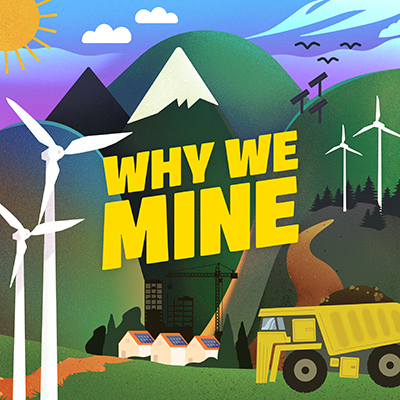
EPISODE 5
Episode 5: Mining and Investing in Global Communities
How does the mining industry ensure it builds strong relationships with communities and Indigenous Peoples, respects human rights, and creates lasting benefits in the regions where it operates? In this episode, we explore the many ways mining companies co

EPISODE 4
Episode 4: Fresh Water Solutions
Water is an essential resource for people, communities and the environment, and it’s also critical to the mining process. In this episode, we highlight the innovative ways the mining industry approaches water use, from groundwater-scarce regions of Chile
